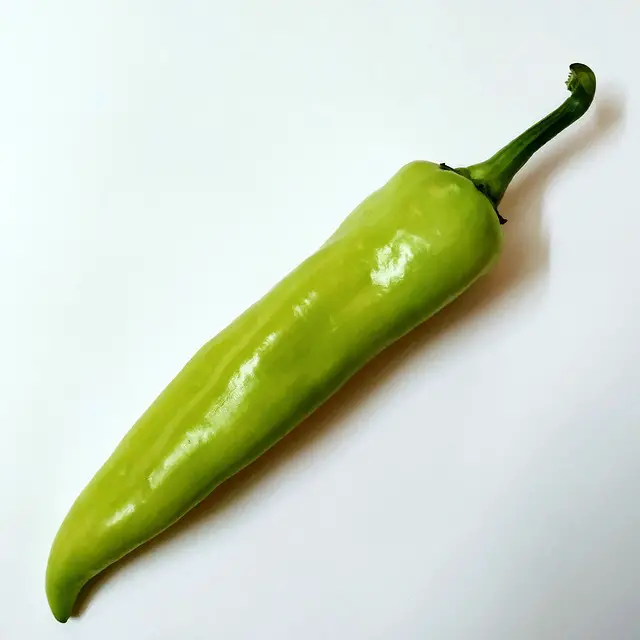Banana peppers are sweeter with a milder taste compared to the tangy and slightly spicy profile of pepperoncini. Both types of peppers can be used in various recipes such as salads, sandwiches, pizzas, or even pickling.
Banana Peppers
(Image by Chandrachood from Pixabay)

Banana peppers are a type of sweet pepper that is commonly used in cooking. They have a mild, tangy flavor that makes them versatile in many dishes, from salads and sandwiches to pizzas and pasta sauces.
One unique thing about banana peppers is their shape – they’re long and narrow with a curved end, resembling the fruit they’re named after. They can be found fresh or pickled in jars at grocery stores.
When it comes to nutrition, banana peppers are low in calories but high in Vitamin C. They also contain small amounts of other nutrients like Vitamin A and potassium.
Banana peppers add a subtle sweetness to dishes without overpowering other flavors. If you’re looking for ways to use them in recipes, try stuffing them with cheese or slicing them up as a pizza topping!
Pepperoncini
(Photo by J. L. Fizzell)

Pepperoncini is a type of pepper that originated in Italy. It is also known as Tuscan Pepper and Golden Greek Pepperoncini. These peppers are small, elongated, and usually yellow or green in color. They have a mild to medium level of heat and are often pickled.
Pepperoncini peppers have a slightly sweet taste with a hint of tanginess. They can be eaten raw or cooked, but they are most commonly used as an ingredient for salads, sandwiches, pizzas, soups, stews, and pasta dishes.
These peppers contain capsaicin which has been proven to provide numerous health benefits such as reducing inflammation and boosting metabolism. In addition to this, they are low in calories making them an excellent choice for people who want to maintain their weight without sacrificing flavor.
If you’re looking for ways to incorporate pepperoncini into your diet try adding them to your next salad or sandwich instead of regular bell peppers!
Banana peppers Vs. Pepperoncini – Key differences
Banana peppers and pepperoncini may look similar, but they have distinct differences that set them apart. One of the key differences is their taste – banana peppers are milder with a sweet flavor while pepperoncini has a more tangy and slightly spicy taste.
Another difference is their origin – banana peppers originated from South America, while pepperoncini came from Italy. In terms of appearance, banana peppers are longer and thicker than pepperoncini which are shorter and thinner.
When it comes to nutrition, both types of peppers contain vitamin C, but in different amounts. Banana peppers have higher amounts of vitamin C compared to pepperoncini.
These two varieties serve different culinary purposes – banana peppers work well in salads or as toppings on pizzas and sandwiches. On the other hand, you will often find pickled pepperoncinis used in antipasto platters or added to Greek dishes such as gyros.
Understanding these key differences between the two types of peppers can help elevate your cooking game by choosing the right one for your recipe!
Recipes Using Banana Peppers
Banana peppers are a versatile ingredient that can be used in a wide variety of dishes. They have a mild, sweet flavor and are available fresh or pickled. Here are some recipe ideas to make the most out of your banana peppers.
One classic recipe is stuffed banana peppers. These can be filled with ground beef, sausage, cheese, or any combination you like. Bake them until they’re tender and the filling is cooked through for a delicious appetizer or side dish.
Another option is to add sliced banana peppers to sandwiches or wraps for an extra pop of flavor and crunch. They pair well with deli meats such as turkey, ham, or roast beef.
For those who enjoy spicy food, try making homemade hot sauce using banana peppers as the base ingredient. Blend together roasted bananas peppers with vinegar and other spices like garlic and cumin for a flavorful condiment.
Don’t forget about pickled banana pepper rings! These tangy slices can be added on top of pizza, salads, burgers or tacos for an extra burst of flavor.
There are endless possibilities when it comes to incorporating banana peppers into your cooking repertoire- so get creative!
Recipes Using Pepperoncini
Pepperoncini is a versatile pepper that can add a punch of flavor to various dishes. Whether you like them mild or hot, there are plenty of recipes out there that incorporate this tangy pepper.
One classic recipe using pepperoncini is the Italian beef sandwich. The sliced roast beef and sautéed onions are cooked with beef broth and seasoned with garlic powder, dried oregano, and of course, pepperoncini peppers.
Another delicious way to use these peppers is in a Greek salad. Simply chop up some cucumbers, tomatoes, red onion, feta cheese, olives and top it off with sliced pepperoncinis for an extra kick of flavor.
For those who love pasta dishes, try adding chopped pepperoncinis to your favorite spaghetti sauce recipe. It’s an easy way to add some spice without overwhelming the dish.
If you’re feeling adventurous in the kitchen and want to try something new, consider making stuffed chicken breasts with cream cheese and chopped pepperoncinis for added texture and flavor.
When it comes to cooking with Pepperoncini peppers – the possibilities are endless!
Can you substitute banana peppers for pepperoncini?
If you’re wondering whether or not you can substitute banana peppers for pepperoncini, the answer is yes! Both of these peppers have a similar taste profile and are often used in salads, sandwiches, and as toppings for pizzas.
However, it’s important to note that there are some key differences between the two. Banana peppers are larger and milder than pepperoncini. They also have a slightly sweet flavor with a hint of tanginess.
On the other hand, pepperoncini is smaller and spicier than banana peppers. It has a distinct vinegary taste that adds depth to dishes like antipasti platters or Greek salads.
So while they can be substituted for each other in most recipes without too much trouble, keep in mind that the final dish may turn out slightly different depending on which one you use.
Ultimately, whether you choose to use banana peppers or pepperoncini will depend on your personal preference and what flavors you want to highlight in your recipe.
What country eats the spiciest food in the world?
Spicy food has been a staple in many cultures for centuries. However, when it comes to the spiciest food in the world, one country stands out: India.
Indian cuisine is known for its use of spices and heat. From dishes like vindaloo to biryani, Indian food packs a punch with its liberal use of chili peppers, ginger, garlic and more. In fact, the Bhut Jolokia pepper – also known as the Ghost Pepper – originated from India and was once considered the hottest pepper in the world.
But why does India have such a love affair with spice? Some believe that it’s due to their hot climate; spicy foods can help cool down your body by making you sweat. Others suggest that it may be because ancient Indians believed that consuming spicy foods could boost immunity and improve digestion.
Regardless of why they do it, there’s no denying that Indians take their spice seriously. So if you’re looking for an adventure (and some serious heat), try some authentic Indian cuisine – just be sure to have plenty of water on hand!
Featured Image By – Chandrachood from Pixabay








